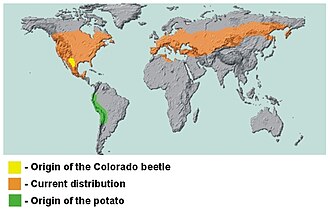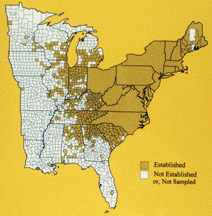Especialidades JA/Agricultura/Respuestas
1
2
- Clay
- Clayey soils are made from very fine particles which stick together easily. Water does not easily soak through clayey soils, but once it penetrates, the clay holds it well. It must be broken up before it can be used for agriculture. This can be done by mixing it with sand, sawdust, wood chips, lime, or manure. Crops that grow well in clayey soils include celery, wheat, oats, beans, and clover.
- Sand
- Sandy soils are made from coarse particles. Water soaks into sand quickly, but will not remain there for very long. This can be addressed by adding clayey soil to it. Crops that grow well in sandy soil include melons, cucumbers, peaches, peanuts, and beans.
- Loam
- Loam is soil composed of sand, silt, manure, and clay in relatively even concentration (about 40-40-10-10% concentration respectively). Loams are gritty, plastic when moist, and retain water easily. They generally contain more nutrients than sandy soils. In addition to the term loam, different names are given to soils with slightly different proportions of sand, silt, manure and clay: sandy loam, silty loam, clay loam, sandy clay loam, silty clay loam, and manural loam. Loam soil is ideal for growing crops because it retains nutrients well and retains water while still allowing the water to flow freely. This soil is found in a majority of successful farms in regions around the world known for their fertile land. Crops that do well in loamy soil include barley, turnips, and potatoes.
3
First, wrap each variety seeds in a paper towel. Then dampen the paper towels and place them each inside their own clear plastic bag (such as a sandwich bag or a freezer bag) so that they retain moisture. Do not seal the bags. Place the bags in a warm place. After three days, carefully remove the paper towel from each bag, open it, and count the number of seeds that have sprouted. If you started with 100 seeds as per this requirement, the germination percentage will equal the number of seeds that have sprouted. Write this percentage down for each variety.
La especialidad de Semillas - Avanzado tiene un requisito similar, entonces considere desarrollarlas juntas.
4
Fertilizers can be divided into macronutrients or micronutrients based on their concentrations in plant dry matter. There are six macronutrients: nitrogen, phosphorus, and potassium, often termed "primary macronutrients" because their availability is usually managed with NPK fertilizers, and the "secondary macronutrients" — calcium, magnesium, and sulfur — which are required in roughly similar quantities but whose availability is often managed as part of liming and manuring practices rather than fertilizers. The macronutrients are consumed in larger quantities and normally present as a whole number or tenths of percentages in plant tissues (on a dry matter weight basis). There are many micronutrients (such as boron, chlorine, manganese, iron, zinc, copper, and molybdenum), required in concentrations ranging from 5 to 100 parts per million (ppm) by mass.
5
Chenopodium album
| Chenopodium album (Fat hen) | |
|---|---|
|
Where found: Worldwide
Description: Chenopodium album is a fast-growing weedy annual plant in the genus Chenopodium. The standard English name is Fat-hen; other names include white goosefoot, lamb's quarters, pigweed or dungweed, or more ambiguously as just goosefoot.
Control: It may be controlled by dark tillage, rotary hoeing, or flaming when the plants are small. Crop rotation of small grains will suppress an infestation. It is, however, difficult to control with chemical means.
|
 |
Stellaria
| Stellaria (Chickweed) | |
|---|---|
|
Where found: Europe, North America
Description: Stellaria is a genus of about 90-120 species flowering plants in the family Caryophyllaceae, with a cosmopolitan distribution. Common names include stitchwort and chickweed.
Control: Control is difficult due to the heavy seed sets, although herbicides are effective when the plants are small. Common Chickweed is very competitive with small grains, and can produce up to 80% yield losses among barley.
|
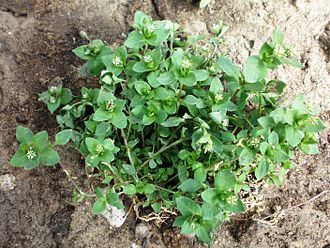 |
Cirsium arvense
| Cirsium arvense (Creeping thistle) | |
|---|---|
|
Where found: Native throughout Europe and northern Asia, and widely introduced elsewhere.
Description: It is a tall herbaceous perennial plant, forming extensive clonal colonies from an underground root system that sends up numerous erect stems each spring, reaching 1–1.2 m tall (occasionally more); the stems often lie partly flat by summer but can stay erect if supported by other vegetation. The leaves are very spiny, lobed, up to 15–20 cm long and 2–3 cm broad (smaller on the upper part of the flower stem). The inflorescence is 10–22 mm diameter, pink-purple, with all the florets of similar form (no division into disc and ray florets).
Control: This plant is extremely difficult to control, as it can regrow from fairly small root fragments and is resistant to many herbicides.
|
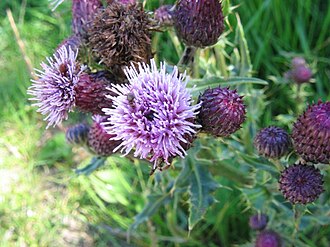 |
6
Slug
| Limax maximus (Great Grey Slug) | |
|---|---|
|
Where found: Native to Europe, the slugs have been introduced to Northern America and occur along the East and West sides of that continent. The slugs are almost always found near human habitation — usually in lawns, gardens, cellars or in other damp areas.
Description: The Great Grey Slug, Limax maximus (literally, "great slug"), also known as the Tiger slug or the Spotted leopard slug, is one of the largest kinds of keeled slug (second only to Limax cinereoniger). The species is noted for its dark-spotted pale-grey body and the short keel on its tail. These nocturnal animals can grow to be as long as 8 inches (20 cm), feeding mostly on rotting plant matter and fungi. They live for up to three years and are inactive during the winter.
Affected crops: Lettuce and cabbage are their favorites, but they will eat about anything.
Control: Diatomite is a naturally occurring, soft, chalk-like sedimentary rock that is easily crumbled into a fine white to off-white powder. It is sometimes used as an insecticide, due to its physico-sorptive properties. The fine powder absorbs lipids from the cuticle, the waxy outer layer of insects' exoskeletons, causing them to dehydrate. This also works against gastropods and is commonly employed in gardening to defeat slugs. However, since slugs inhabit humid environments, efficacy is very low. It is sometimes mixed with an attractant or other additives to increase its effectiveness.
Among the disadvantages of using diatomaceous earth for pest control include the health risk to humans (see below), and that it is harmful to the many insects that are beneficial to gardens, including predatory beetles and bugs and many detritivores (such as earthworms). One mechanical control is to cut a soda bottle in half and place it around the plants to keep slugs out. This is obviously labor intensive, and is therefore not practical for large crops. |
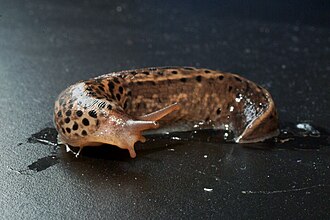 |
Colorado potato beetle
| Leptinotarsa decemlineata (Colorado potato beetle) | |
|---|---|
|
Where found: Native to the Southwestern USA and Mexico, the Colorado potato beetle spread through the rest of the country, and into much of Canada. It then spread to continental Europe and Asia.
Description: The Colorado potato beetle (Leptinotarsa decemlineata, also known as the Colorado beetle, ten-striped spearman, the ten-lined potato beetle) is an important pest of potato crops. It is approximately 10 mm (0.4 inches) long, with a bright yellow/orange body and 5 bold brown stripes along the length of each of its elytra, and it can easily be confused with its close cousin and look-alike, the false potato beetle
Affected crops: Potato, tomato, eggplant, pepper
Control: Insecticides are often unsuccessful when used against Leptinotarsa because of the beetle's resistance to toxins and ability to rapidly develop resistance to them. The Colorado beetle has developed resistance to all major insecticide classes. In areas where the CPB has not developed resistance to pesticides, it is crucially important to not repeated reuse the same type of chemical control, or the CPB will develop resistance to it.
The CPB can be hand picked from the plants. Crop rotation is another effective strategy, the key being to put next year's potato crop as far as possible from last year's crop. Plants can also be covered with floating row covers - a thin fabric which allows moisture and air to circulate, but prevents access to the plants by the beetle.
|
 |
Japanese beetle
| Popillia japonica (Japanese beetle) | |
|---|---|
|
Where found: As the name suggests, the Japanese beetle is native to Japan. The insect was first found in the United States in 1916 in a nursery near Riverton, New Jersey. It is thought that beetle larvae entered the United States in a shipment of iris bulbs prior to 1912 when inspections of commodities entering the country began.
Description: The Japanese beetle (Popillia japonica) is a beetle about 1.5 cm (0.6 inches) long and 1 cm (0.4 inches) wide (smaller in Canada), with shiny copper-colored elytra and a shiny green top of the thorax and head. It is not very destructive in Japan, where it is controlled by natural enemies, but in America it is a serious pest.
Affected crops: Rose bushes, grapes, canna, crape myrtles, squash, strawberries, tomatoes, peppers, grapes, plums, pears, peaches, raspberries, blackberries, corn, peas and other plants.
Control: During the larval stage, the Japanese beetle lives in lawns and other grasslands, where it eats the roots of grass. During that stage, it is susceptible to a fatal disease called milky spore disease, caused by a bacterium called milky spore, Paenibacillus (formerly Bacillus) popilliae. The USDA developed this biological control and it is commercially available in powder form for application to lawn areas. Standard applications (low density across a broad area) take from one to five years to establish maximal protection against larval survival (depending on climate), expanding through the soil through repeated rounds of infection, in-host multiplication, release from killed host, and infection. Typically proper application can lead to a 15-20 year period of protection.
On field crops such as squash, floating row covers can be used to exclude the beetles, however this may necessitate hand pollination of flowers. Kaolin sprays can also be used as barriers. Research performed by many US extension service branches has shown that pheromone traps may attract more beetles than they catch, and so they have fallen out of favor. Natural repellents include catnip, chives, garlic, and tansy, as well as the remains of dead beetles. |
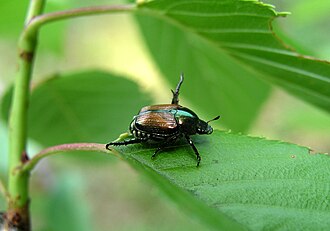 |
European corn borer
| Ostrinia nubilalis (European corn borer) | |
|---|---|
|
Where found: Native to Europe although it is found in North America as well
Description: The European Corn Borer (Ostrinia nubilalis) is a pest of corn. Female corn borer moths lay clusters of eggs on corn leaves, usually on the underside of the leaf.
The egg masses, or clusters, are laid in an overlapping configuration and are whitish-yellow in color. As the larvae develop inside their eggs, the eggs become more and more transparent and the immature caterpillar's black head is eventually visible. The caterpillars hatch by chewing their way out of the eggs. European corn borer caterpillars damage the ears of corn, as well as the stalks, chewing tunnels which cause the plants to fall over.Affected crops: Corn
Control: Biological control agents of corn borers include the hymenopteran parasitoid Trichogramma.
|
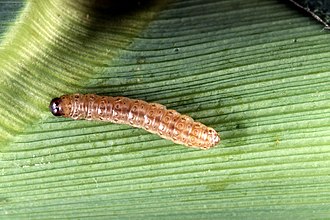 |
Boll weevil
| Anthonomus grandis (Boll weevil) | |
|---|---|
|
Where found: Thought to be native to Central America, it migrated into the US from Mexico in the late 19th century and had infested all US cotton-growing areas by the 1920s, devastating the industry and the people working there and traumatizing the people of the American south. During the late 20th century it became a serious pest in South America as well.
Description: The boll weevil (Anthonomus grandis) is a beetle measuring an average length of six millimeters, which feeds on cotton buds and flowers.
Affected crops: Cotton
Control: The Boll Weevil Eradication Program is a program sponsored by the United States Department of Agriculture (USDA) that has sought to eradicate the boll weevil in the cotton-growing areas of the United States. It is one of the world's most successful implementations of integrated pest management. Three main techniques are employed over a 3- to 5-year period: pheromone traps for detection, cultural practices to reduce the weevil’s food supply, and malathion treatments. During the first year, applications of malathion are made every five to seven days starting in late summer. The frequency is reduced to every 10 days during the later part of the growing season until the first frost. The cotton stalks are shredded and plowed into the ground to eliminate their use as a winter shelter. During years 2 through 5, the automatic spraying is supplemented by an intensive trapping program (one trap per 1-2 acres), and malathion applications are made only in those fields where weevils are detected. This phase begins in late spring and continues until the first killing frost. The final phase of the program involves monitoring and trapping at a density of one trap per 10 acres, with spot spraying as required. The program has become more high-tech in recent years, employing GPS mapping technology and bar code readers that transmit trap data electronically.
|
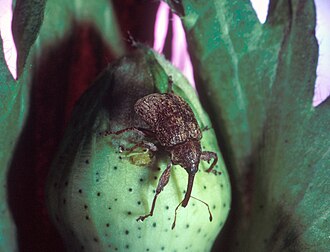 |
Cutworm
| Noctuidae (Cutworm) | |
|---|---|
|
Where found: Their distribution is worldwide.
Description: The term cutworm is used for the larvae of many species of moth. Most cutworms are in the moth family Noctuidae, however, many noctuid larvae are not cutworms. Cutworms are notorious agricultural and garden pests. They are voracious leaf, bud, and stem feeders and can destroy entire plants. They get their name from their habit of "cutting" off a seedling at ground level by chewing through the stem. Some species are subterranean and eat roots. Cutworms are usually green, brown, or yellow soft-bodied caterpillars, often with longitudinal stripes, up to one inch in length. There are many variations across the genera.
Affected crops: Most often tomato, pepper, pea, or bean
Control: While there are pesticides which can control these insects, the non-industrial gardener can protect threatened plants by simply impeding the ground-hiding cutworm caterpillar from climbing the plant; they hide in the soil near the plants and climb them at night.
To prevent this, one can:
|
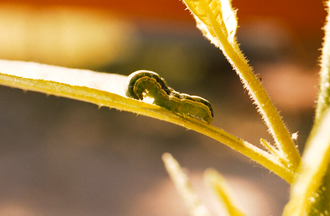 |
Brown marmorated stink bug
| Halyomorpha halys (Brown marmorated stink bug) | |
|---|---|
|
Where found: The brown marmorated stink bug is believed to have "hitched a ride" to the United States as a stowaway in packing crates from Asia; it was accidentally introduced there from China or Japan. Its native range also includes Korea and Taiwan.
Description: Looks similar in appearance to other native species of shield bugs including Acrosternum, Euschistus, and Podisus, except that several of the abdominal segments protrude from beneath the wings and are alternatively banded with black and white (visible along the edge of the bug even when wings are folded) and a white stripe or band on the next to last (4th) antennal segment. The adults are approximately 5/8 inch long and the underside is white or pale tan, sometimes with grey or black markings. The legs are brown with faint white banding.
Affected crops: Fruits, vegetables, soybeans
Control: Infestations should be reported to your local county Cooperative Extension office as this is a fairly new species to invade the United States. They will be able to help you control them.
|
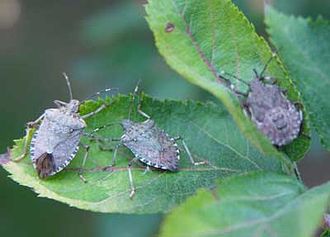 |
7
Climate is what to expect. Weather is what you get. Climate is basically a long-term average of what the weather has done in the past.
Knowing the climate helps the farmer plan agricultural activities such as planting and harvesting, as well as assisting in crop selection. Crops need to be in the ground early enough that they will be able to produce their yield before the first frost, but late enough to avoid springtime frosts. The climate tells the farmer how many growing days to expect, and that can be compared to the number of growing days required by various crops. Some crops also need to be harvested before the weather gets too hot, and other crops may allow multiple plantings and harvestings per season.
Weather also plays a hand in timing agricultural activities. A field needs to dry out before it is plowed, and then it may need to dry out for a few more days before it is disced. Dry weather is also needed to allow hay time to cure between mowing and bailing, and it is sometimes important when applying fertilizers or pesticides.
8
Your log need not be any more complicated than a notebook and pen. You could include information such as:
- Plowing/Discing
- When was it done?
- What was the condition of the soil?
- Cost
- Planting
- Date
- Amount of seed used
- Method (how was the planting done?)
- Cost
- Fertilizer
- When applied
- What kind was applied
- Cost
- Pest Control
- Dates and types of pesticides and herbicides
- Cultivation dates
- Mechanical/cultural controls applied
- Cost
- Irrigation
- Dates
- Rainfall dates
- Cost
- Harvest
- Date
- Yield
9
9a
The primary purpose of plowing is to turn over the upper layer of the soil, bringing fresh nutrients to the surface, while burying weeds and the remains of previous crops, allowing them to break down. It also aerates the soil, and allows it to hold moisture better. In modern use, a plowed field is typically left to dry out, and is then harrowed before planting.
9b
Disking is often carried out on fields to follow the rough finish left by plowing operations. The purpose of this is generally to break up clods and lumps of soil and to provide a finer finish, a good tilth or soil structure that is suitable for seeding and planting operations.
9c
A cultivator is a farm implement for stirring and pulverizing the soil, either before planting or to remove weeds and to aerate and loosen the soil after the crop has begun to grow.
9d
Irrigation is the artificial application of water to the soil for assisting in growing crops. In crop production it is mainly used in dry areas and in periods of rainfall shortfalls, but also to protect plants against frost.
9e
The purpose of harvesting is to collect the salable product grown in a field when it reaches maturity.
10
The greatest benefit birds provide to farmers is their voracious appetites for insects.
Please consult Wikibooks' Field Guide to Birds to help you identify ten birds in your area. As of this writing, this field guide is still in its infancy, so you might be well served to purchase a more thorough field guide. Field guides are generally tailored to a specific area of the world, so be sure to consult one that covers your area.
11
Erosion is the displacement of soil by wind, water, or ice by downward or down-slope movement. It can occur quickly on steep ground - especially if there is nothing growing there. It can be slowed by minimizing the amount of time the land has nothing growing on it. When plowing, discing, or planting, it is best to make furrows perpendicular to the slope of the ground. Plowing straight uphill will cause furrows to act as ever-widening ditches that channel the water quickly away, carrying soil with it. Plowing across a hill instead slows the descent of rainwater and allows it to drop the sediments it picks up rather than carrying it off.
12
USA
The Cooperative Extension Service, also known as the Extension Service of the USDA, is a non-formal educational program implemented in the United States designed to help people use research-based knowledge to improve their lives. The service is provided by the state's designated land-grant universities. In most states the educational offerings are in the areas of agriculture and food, home and family, the environment, community economic development, and youth and 4-H. The Cooperative State Research, Education, and Extension Service of the USDA administers funding for Smith Lever Act services in cooperation with state and county governments and land-grant universities.
This table summarizes the cooperative extension programs in each state. (Under the 1890 amendment to the Morrill Act, if a state's land-grant university was not open to all races, a separate land-grant university had to be established for each race. Hence, some states have more than one land-grant university.)
| State | University | Extension Website |
|---|---|---|
| Alabama | Alabama A&M University Auburn University Tuskegee University& |
Alabama Cooperative Extension System |
| Alaska | University of Alaska | University of Alaska Cooperative Extension |
| Arizona | University of Arizona | Arizona Cooperative Extension |
| Arkansas | University of Arkansas University of Arkansas at Pine Bluff |
University of Arkansas Cooperative Extension Service |
| California | University of California | University of California Cooperative Extension |
| Colorado | Colorado State University | Colorado State Cooperative Extension |
| Connecticut | University of Connecticut | Connecticut Cooperative Extension System |
| Delaware | University of Delaware Delaware State University |
Delaware Cooperative Extension DSU Cooperative Extension |
| District of Columbia | University of the District of Columbia | University of the District of Columbia Cooperative Extension Service |
| Florida | University of Florida Florida A&M University |
University of Florida IFAS Extension |
| Georgia | University of Georgia Fort Valley State University |
University of Georgia Cooperative Extension |
| Hawaii | University of Hawaii | University of Hawaii Cooperative Extension Service |
| Idaho | University of Idaho | University of Idaho Extension |
| Illinois | University of Illinois | University of Illinois Extension |
| Indiana | Purdue University | Purdue University Extension |
| Iowa | Iowa State University | Iowa State University Extension |
| Kansas | Kansas State University | Kansas State University Research & Extension |
| Kentucky | University of Kentucky | University of Kentucky Cooperative Extension Service |
| Louisiana | Louisiana State University Southern University and A&M College |
Louisiana Cooperative Extension Service |
| Maine | University of Maine | University of Maine Extension |
| Maryland | University of Maryland University of Maryland Eastern Shore |
Maryland Cooperative Extension |
| Massachusetts | University of Massachusetts | University of Massachusetts Extension |
| Michigan | Michigan State University | Michigan State University Extension |
| Minnesota | University of Minnesota | Minnesota Extension Service |
| Mississippi | Mississippi State University Alcorn State University |
Mississippi State University Extension |
| Missouri | University of Missouri Lincoln University |
University of Missouri Extension |
| Montana | Montana State University | Montana State University Extension Service |
| Nebraska | University of Nebraska | University of Nebraska Cooperative Extension |
| Nevada | University of Nevada | University of Nevada Cooperative Extension |
| New Hampshire | University of New Hampshire | University of New Hampshire Cooperative Extension |
| New Jersey | Rutgers University | Rutgers Cooperative Extension |
| New Mexico | New Mexico State University | New Mexico State University Cooperative Extension Service |
| New York | Cornell University | Cornell Cooperative Extension |
| North Carolina | North Carolina State University North Carolina A&T State University |
North Carolina Cooperative Extension Service North Carolina A&T State University Cooperative Extension Program |
| North Dakota | North Dakota State University | North Dakota State University Extension Service |
| Ohio | Ohio State University | The Ohio State University Extension |
| Oklahoma | Oklahoma State University | Oklahoma Cooperative Extension Service |
| Oregon | Oregon State University | Oregon State University Extension Service |
| Pennsylvania | Penn State | Penn State Cooperative Extension |
| Rhode Island | University of Rhode Island | University of Rhode Island Cooperative Extension |
| South Carolina | Clemson University South Carolina State University |
Clemson University Cooperative Extension Service |
| South Dakota | South Dakota State University | South Dakota State University Cooperative Extension Service |
| Tennessee | University of Tennessee Tennessee State University |
University of Tennessee Extension Tennessee State University Cooperative Extension Program |
| Texas | Texas A&M University Prairie View A&M University |
Texas AgriLife Extension Service |
| Utah | Utah State University | Utah State University Extension |
| Vermont | University of Vermont | University of Vermont Extension System |
| Virginia | Virginia Tech Virginia State University |
Virginia Cooperative Extension |
| Washington | Washington State University | Washington State University Extension |
| West Virginia | West Virginia University | West Virginia University Extension Service |
| Wisconsin | University of Wisconsin-Extension | University of Wisconsin Extension |
| Wyoming | University of Wyoming | University of Wyoming Cooperative Extension Service |
Canada
Agriculture extension (the process of sharing agricultural research with the farming community) is the responsibility of provincial governments in Canada. Contact your Provincial Ministry of Agriculture for contact information for the appropriate office near you.
References
- ↑ http://www.csrees.usda.gov/qlinks/partners/partners_list.pdf Retrieve 2007-10-22.
- ↑ Although Tuskeegee University has been a private university, it began to receive Cooperative Extension funding in 1972.
